Introduction
Baked beans have long been a staple in many kitchens worldwide. Their rich, hearty flavor combined with their versatility makes them a go-to dish for countless meals. Whether you enjoy them as a main dish or a side, baked beans are more than just food—they’re a tradition. But have you ever wondered why homemade bread and baked beans are such a classic pairing? This article will delve into everything you need to know about baked beans, from their history to tips for making the perfect batch at home.
What Are Baked Beans?
Baked beans are a traditional dish made by slow-cooking beans in a flavorful sauce. Typically, the sauce includes ingredients like tomatoes, molasses, and spices, creating a balance of sweet and savory flavors.
Historically, baked beans trace their origins back to Native American cuisine, where beans were slow-cooked with maple syrup. Over time, the recipe evolved, gaining popularity in Europe and later in American households. Today, they’re enjoyed in countless variations worldwide, often served with homemade bread to soak up the flavorful sauce.
- Common beans used: navy beans, pinto beans, and kidney beans
- Popular cooking methods: stovetop, oven, and slow cooker
Baked beans not only offer delicious flavor but also a fascinating glimpse into culinary history.
Health Benefits
Baked beans are more than just comfort food—they’re a powerhouse of essential nutrients that contribute to overall well-being. Beyond their delicious taste, they offer significant health advantages, making them a smart addition to any meal. With a combination of fiber, protein, and vital vitamins, baked beans are not just tasty; they’re a nutritious choice that supports a healthy lifestyle.
One of the standout features of baked beans is their high fiber content, which plays a crucial role in digestive health. Fiber promotes regular bowel movements, prevents constipation, and can even help manage weight by keeping you fuller for longer. Additionally, it contributes to reducing bad cholesterol levels, which can lower the risk of heart disease.
Baked beans are also rich in vitamins and minerals like iron, magnesium, and potassium. These nutrients are essential for maintaining strong muscles, a robust immune system, and a healthy heart. For instance, potassium helps regulate blood pressure, while magnesium supports bone health and energy production.
Another benefit is that baked beans are naturally low in fat, making them a heart-healthy option compared to many other side dishes. This quality makes them suitable for a wide range of dietary preferences, including low-fat and calorie-conscious diets.
For those following a vegetarian diet, baked beans are an excellent source of plant-based protein. Protein is essential for repairing tissues, building muscle, and maintaining overall bodily functions. Since baked beans contain both protein and fiber, they provide sustained energy without causing spikes in blood sugar levels, making them a great option for people managing diabetes.
When paired with homemade bread, baked beans create a wholesome, satisfying meal that combines rich flavors with balanced nutrition. The bread complements the beans by absorbing their savory sauce, enhancing both texture and taste. Together, they form a meal that’s not only comforting but also packed with benefits for your health.
Essential Ingredients
Creating the perfect baked beans starts with selecting the right ingredients. While traditional recipes call for simple pantry staples, each ingredient plays a vital role in the final flavor.
Key components of baked beans:
- Beans: Navy beans are the most commonly used, but pinto or kidney beans work well too.
- Tomato Base: Often made with tomato sauce or paste for richness.
- Sweeteners: Molasses, brown sugar, or maple syrup add depth.
- Seasonings: Mustard, onion, garlic, and a touch of paprika create a balanced flavor.
To elevate your dish, consider pairing your baked beans with freshly baked homemade bread. The bread’s soft texture perfectly complements the beans’ rich sauce.
Equipment Needed
Making baked beans at home requires minimal equipment, but having the right tools ensures a smooth cooking process. Whether you’re a beginner or an experienced cook, here are the essentials:
- Large Pot or Dutch Oven: Ideal for stovetop or oven cooking.
- Slow Cooker: Perfect for achieving tender beans with minimal effort.
- Mixing Bowls: Useful for preparing and combining ingredients.
- Measuring Cups and Spoons: Essential for accuracy.
If you’re baking homemade bread to serve alongside, a stand mixer and loaf pan are highly recommended. Investing in the right equipment makes it easier to prepare consistently delicious meals.
Step-by-Step Recipe
Creating baked beans at home is simple, but attention to detail makes all the difference. Here’s a step-by-step guide:
- Prepare the Beans: Soak dried beans overnight, then rinse and boil until tender.
- Make the Sauce: In a separate pot, combine tomato sauce, molasses, brown sugar, and seasonings.
- Combine and Cook: Add the cooked beans to the sauce and transfer everything to a Dutch oven or slow cooker.
- Bake or Slow-Cook: Bake at 350°F for 2-3 hours or cook in a slow cooker on low for 6-8 hours.
- Serve: Pair with homemade bread for the perfect meal.
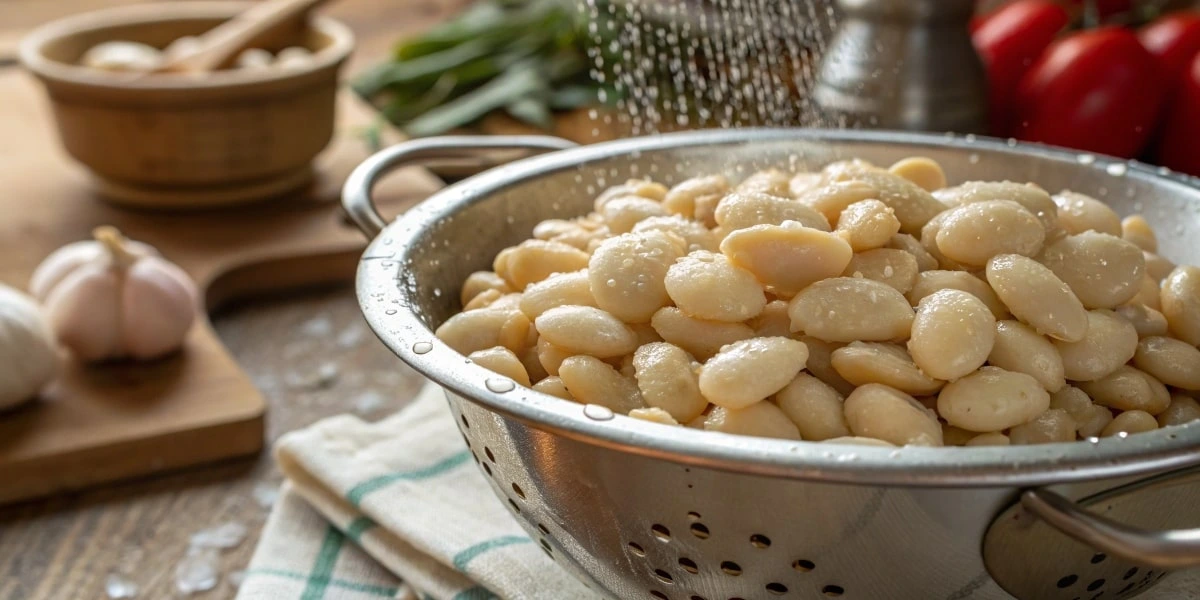
Each step contributes to the rich, comforting flavor that makes baked beans a family favorite.
Tips for Perfect Baked Beans
Achieving the perfect baked beans requires more than just following a recipe. These tips will help you create a dish that’s flavorful and satisfying:
- Use Fresh Ingredients: Fresh spices and beans make a noticeable difference.
- Balance Sweet and Savory: Adjust the molasses and sugar to suit your taste.
- Cook Low and Slow: Slow cooking ensures the beans absorb the sauce’s flavors.
- Pair Thoughtfully: Serve with warm homemade bread to enhance the experience.
Taking the time to perfect your technique will make your baked beans truly unforgettable.
Common Mistakes to Avoid
Even experienced cooks can encounter challenges when making baked beans. Avoid these common pitfalls to ensure your dish turns out perfectly:
- Undercooking the Beans: Soaking and cooking beans thoroughly is crucial.
- Overloading with Sugar: Too much sweetness can overpower the dish.
- Skipping the Sauce Simmer: Allowing the sauce to simmer enhances its flavor.
- Neglecting Pairings: Forgetting to serve with homemade bread can diminish the meal’s overall appeal.
By steering clear of these mistakes, you’ll achieve consistently delicious results.
Variations and Additions
Baked beans are incredibly versatile, allowing you to tailor the recipe to your preferences. Here are some popular variations:
- Vegan Option: Use vegetable broth and skip meat-based additions.
- Spicy Twist: Add jalapeños or chili powder for a kick.
- Meat Lovers: Include sausage, or smoked ham for added richness.
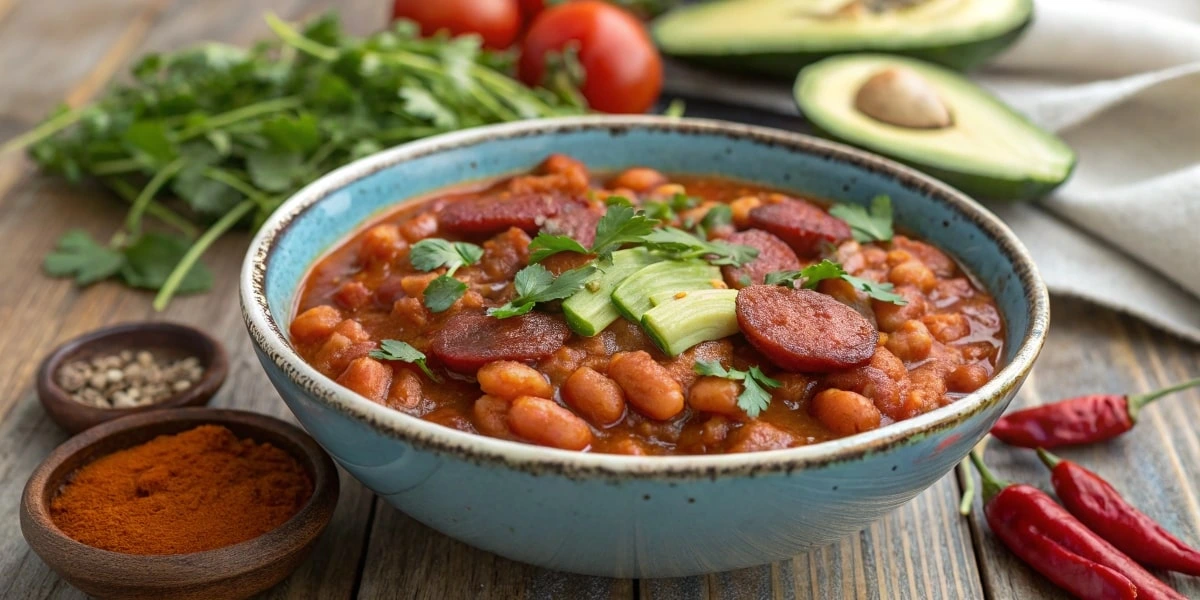
Each variation pairs beautifully with homemade bread, making the dish even more enjoyable.
Pairing Suggestions
Baked beans shine brightest when served alongside complementary dishes. Here are some ideas to complete your meal:
- Proteins: Grilled chicken, roasted turkey, or smoked ribs.
- Sides: Coleslaw, potato salad, or cornbread.
- Drinks: Iced tea or lemonade for a refreshing contrast.
Don’t forget to include homemade bread—it’s the ultimate companion to baked beans.
Storage and Reheating
Leftover baked beans can be just as delicious, if not more flavorful, after resting, as the sauce continues to infuse the beans with richness over time. Proper storage and reheating methods are crucial to preserving both their texture and flavor, ensuring they taste just as satisfying as when they were freshly made.
Storage:
Once the baked beans have cooled to room temperature, transfer them to an airtight container. Make sure the container is properly sealed to prevent air from entering, which can cause the beans to dry out or absorb unwanted odors from the fridge. Stored correctly, baked beans can last up to 5 days in the refrigerator without compromising their quality. For longer storage, consider freezing them. To do so, portion the beans into freezer-safe containers or resealable bags, leaving some space at the top to allow for expansion. Frozen baked beans can be stored for up to 3 months, making them an excellent option for meal prepping.
Reheating:
When reheating baked beans, it’s essential to avoid overcooking, which can lead to mushy textures or burnt sauce. For stovetop reheating, place the beans in a saucepan over low to medium heat. Stir frequently to distribute the heat evenly and prevent sticking. Add a splash of water or broth if the sauce has thickened too much during storage. Alternatively, if you’re short on time, use the microwave. Transfer a portion of beans to a microwave-safe dish, cover it with a lid or damp paper towel, and heat in 30-second intervals, stirring between each interval until the beans are warmed through.
For a meal that feels freshly made, pair reheated beans with a slice of warm homemade bread. The bread’s soft, airy texture complements the beans’ savory sauce, creating a quick yet satisfying meal. Whether you enjoy them as a side dish or a standalone meal, properly stored and reheated baked beans deliver the same comforting flavors every time.
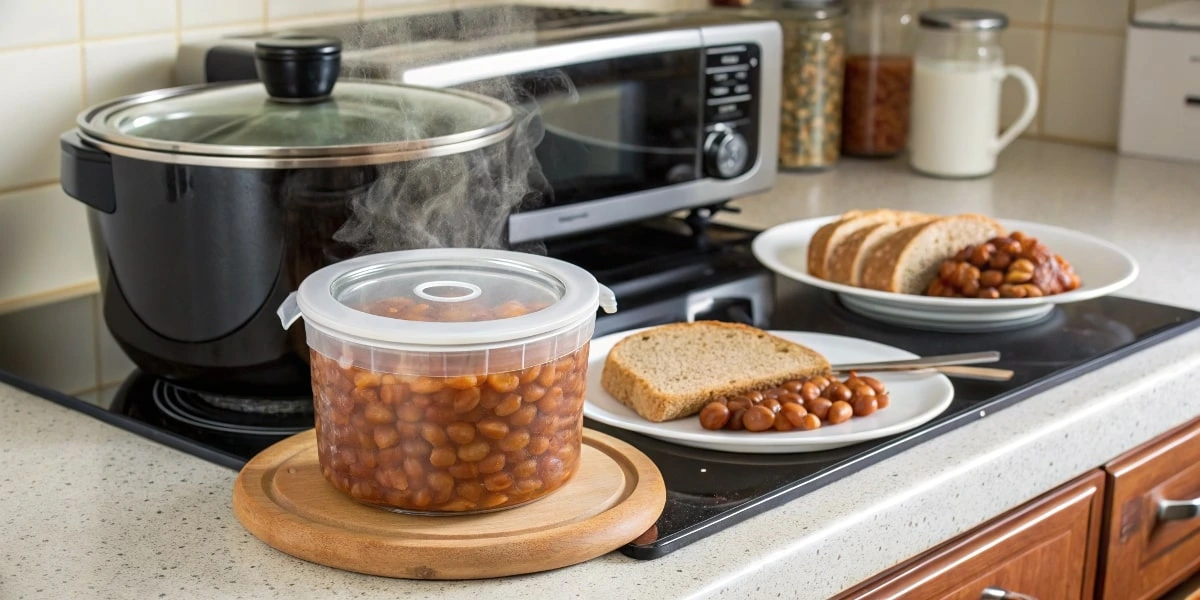
FAQ: Everything You Need to Know About Baked Beans
What can I add to baked beans for flavor?
Enhancing the flavor of baked beans is easy with a few creative additions. You can mix in cooked bacon, smoked sausage, or diced ham for a rich, smoky taste. If you prefer a vegetarian option, try adding caramelized onions, roasted garlic, or a splash of apple cider vinegar for a tangy twist. Sweeteners like brown sugar, maple syrup, or molasses can enhance the sweetness, while mustard, Worcestershire sauce, or chili powder can add depth and spice. Don’t forget fresh herbs like thyme or parsley for a touch of freshness.
How long do baked beans last in the fridge?
Properly stored baked beans can last up to 5 days in the refrigerator. To maximize freshness, allow them to cool completely before transferring them to an airtight container. Always reheat only the portion you plan to eat to avoid repeated heating and cooling, which can shorten their shelf life.
Can I use canned beans?
Absolutely! Canned beans are a convenient alternative to dried beans and can significantly reduce preparation time. Simply rinse them thoroughly to remove excess sodium and any canned flavor before cooking. While canned beans may not absorb flavors as deeply as dried beans, they still produce delicious results, especially when combined with a rich, flavorful sauce.
Are baked beans healthy?
Yes, baked beans are a nutritious option when prepared thoughtfully. They’re high in fiber, which promotes digestive health, and contain plant-based protein, making them an excellent choice for vegetarians. Additionally, they are rich in essential nutrients like iron, magnesium, and potassium. Opt for homemade baked beans to control the sugar and sodium levels, as store-bought versions can sometimes contain added sweeteners and preservatives.
How do I thicken the sauce?
Thickening the sauce for baked beans is simple. You can let the beans simmer uncovered, which allows excess liquid to evaporate and naturally thickens the sauce. Alternatively, mix a tablespoon of cornstarch or flour with water to create a slurry, then stir it into the beans and cook until the sauce reaches your desired consistency. Adding mashed beans to the mix is another great way to thicken the sauce while maintaining its rich flavor.
Why pair baked beans with homemade bread?
The combination of baked beans and homemade bread is classic for good reason. The bread’s soft, fluffy texture is perfect for soaking up the flavorful sauce, ensuring no drop goes to waste. Additionally, homemade bread adds a warm, comforting element that elevates the meal. The pairing is both practical and delicious, offering a balance of textures and flavors that’s hard to beat. Whether it’s a crusty loaf or a soft roll, bread makes baked beans even more satisfying.
This FAQ provides helpful insights into making and enjoying baked beans, offering tips to elevate their flavor and nutritional value. For more delicious ideas, try experimenting with your favorite homemade bread recipes to create the perfect pairing
Cultural Significance
Baked beans hold cultural importance across various regions. In the U.S., they’re a barbecue staple, while in the U.K., they’re a breakfast essential. Each region adds its unique twist, showcasing the dish’s adaptability.
Homemade vs Store-Bought
Making baked beans from scratch offers superior flavor and customization. While store-bought options are convenient, they often lack the depth of homemade bread and beans prepared with care. Homemade versions also allow for healthier ingredient choices.
Conclusion
Baked beans are a timeless dish that continues to delight palates worldwide. By following this guide, you can create a batch that’s flavorful, nutritious, and uniquely your own. Pair with homemade bread to elevate your dining experience further. Happy cooking!
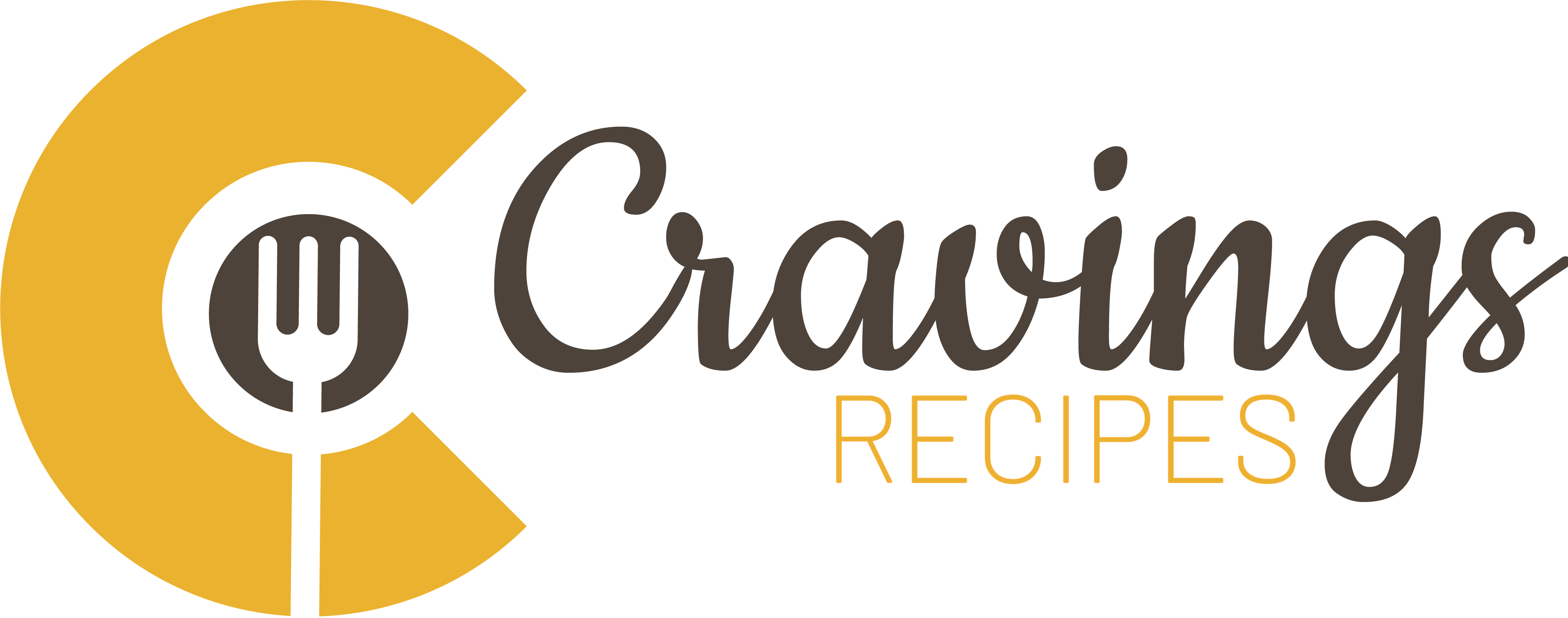
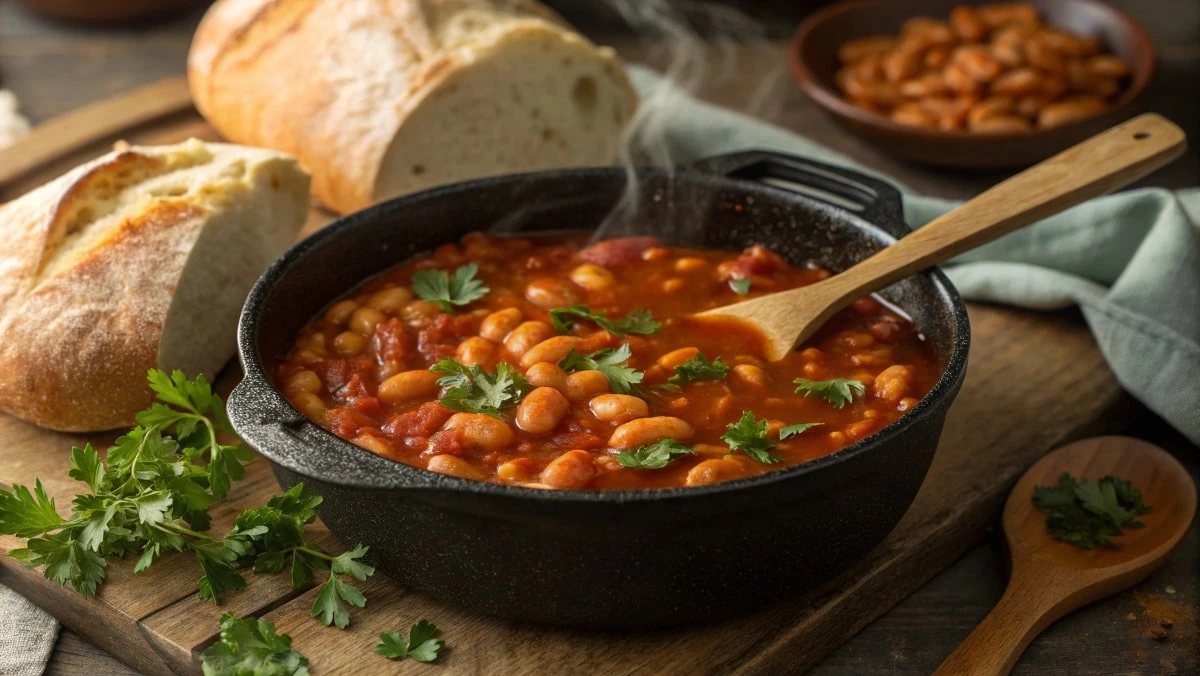
2 thoughts on “Homemade Baked Beans Recipe – A Delicious and Nutritious Classic”